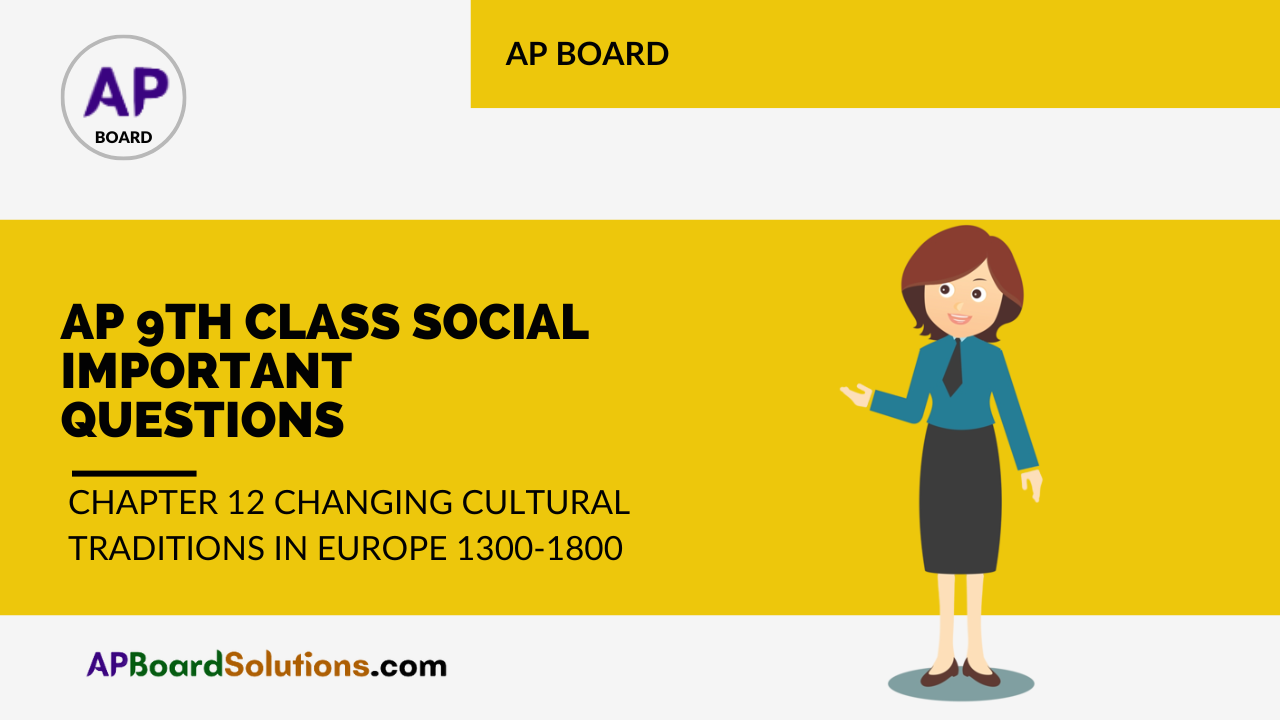These AP 9th Class Social Studies Important Questions 12th Lesson Changing Cultural Traditions in Europe 1300-1800 will help students prepare well for the exams.
AP State Syllabus 9th Class Social 12th Lesson Important Questions and Answers Changing Cultural Traditions in Europe 1300-1800
9th Class Social 12th Lesson Changing Cultural Traditions in Europe 1300-1800 1 Mark Important Questions and Answers
Question 1.
Define Renaissance. (SA-II : 2016-17)
Answer:
Renaissance means “Re birth”. It was a period in Europe, especially Italy when there was a new interest in art, literature, science and learning flourished.
(OR)
Renaissance means the cultural changes in Europe.
9th Class Social 12th Lesson Changing Cultural Traditions in Europe 1300-1800 2 Marks Important Questions and Answers
Question 1.
Study the map given below and answer the following questions. (SA-I : 2018-19)
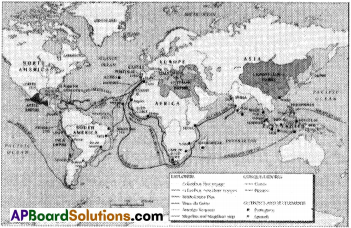
a) From which country did Columbus start his journey?
b) Who discovered the sea route to India?
Answer:
a) Columbus started his journey from the country Spain.
b) Vosco da gama discovered sea route to India in the year 1498 A.D.
Question 2.
Observe the bar graph and answer the questions given (SA-I : 2019-20)

i) What trend does the bar graph show?
Answer:
The bargraph shows the European output of Books 500 -1800. It shows that Manuscript books were avilable from 6th century to 15th century and printed books were started from 15th century.
ii) What could be the possible reason for this trends?
Answer:
Invention of printing press.
![]()
Question 3.
What is the impact of the printing press and how did it change the world? (SA-I : 2019-20)
Answer:
- Printing press made it possible to read books, developing reading habit,s and think rationally.
- A printed book promoting new ideas could quickly reach hundreds of readers.
- Ideas, opinions, and information moves more widely and more rapidly than ever before.
- Humanist culture was spread into entire Europe due to printed books.
9th Class Social 12th Lesson Changing Cultural Traditions in Europe 1300-1800 4 Marks Important Questions and Answers
Question 1.
During medieval and early modern times, women the world over were dominated by men. Is it different now in our present society? Explain. (Sa-III : 2016-17)
Answer:
Compare with medieval and early modern times the present position of women is changing.
In earlier times, women were exploited through every possible means by the society. But at present women become self reliant. Along with the men, women also participated equally in education, medicine, space, agriculture fields, etc.
Not only this, women also participated in politics along with men. Some times they occupies heighest posts in India.
In some sectors, compared to men, women only are in forward position.
But still, in some areas, women were dominated by men and it shows our society is a male dominated society.
![]()
Question 2.
The Renaissance is a period from the 14 to the 17th century, considered the bridge between the Middle Ages and Modern history. It started as a cultural movement in Italy in the Late Medieval period and later spread to the rest of Europe.
In what way do you think that renaissance is a cultural movement? (SA-II : 2018-19)
Answer:
- The Renaissance was a cultural movement.
- It also a revival of the classical art and intellect of Ancient Greece and Rome.
- The art in Renaissance time was more life-like and contained perspective.
- Some famous artists from the Renaissance were Leonardo Davinci, Raphael etc. Now their paintings are really valuable and significant.
- Renaissance artists and architects produced some of the finest works that we know now.
- The Protestant Reformation during the 16th century in Europe ushered in a new artistic tradition that embraced the protestant agenda and diverged drastically from the Southern European tradition and the humanist art produced during the high Renaissance.
Question 3.
| Theory | Important Features |
| 1. Humanism | – Humanists became interested in this world rather than the life after death as the scholars of the Middle Ages had been. |
| – Every thing in nature, science, and the arts that affected man now as important to the Humanists. | |
| 2. Realism | – The Humanist ideas extended to art and architecture too. |
| – Artists observed the nature, the people, and places around them and sought to represent them as they were. | |
| 3. Romanticism | – It is a cultural movement which sought to develop a particular form of nationalist sentiment. |
| Romantic artists and poets generally critised the glorification of reason and science. |
Based on the information given above and answer the following questions,
1. Who gave more importance to the future life than the present life?
2. In which theory can we notice the weakening of the control of religion over human life?
3. The famous statue that depicts Mary holding the body of Zesus reflects which theory?
4. Which theory opposed the glorification of science? (SA-III : 2016-17)
Answer:
- Scholars of the Middle ages.
- Humanism
- Realism
- Romanticism
![]()
Question 4.
The Italian Renaissance was a rebirth of learning that produced many great works of art and literature. (SA-I : 2019-20)
In the context of the above statement, describe how renaissance revolutionized the art and artistic styles?
Answer:
- A reverent revival of classical Greek / Roman art forms and styles.
- A faith in the nobility of man (Humanism).
- The mastery of illusionistic painting techniques, maximising ‘depth’ in a picture, including;
linear perspective, foreshortening and the naturalistic realism of its faces.
9th Class Social 12th Lesson Changing Cultural Traditions in Europe 1300-1800 Important Questions and Answers
Question 1.
Do you think it is important for artists to paint things as they are, that is realistically? Give reasons.
Answer:
- I think it is important to paint realistically.
- Painters should understand the perspective of the painting.
- They should understand changing quality of light, richness of colours.
- They should not completely confine their paintings to rich, powerful, and successful people through this art.
- They should show great interest in the lives of the poor and their sufferings also.
- They should also come under the inflence of other nation’s artists to add life to their paintings.
Question 2.
Why do you think the Popes and bishops encourage the new art?
Answer:
- Before Renaissance, religious art emphasised on religious themes.
- It represented the religious ideals.
- Artists of Renaissance portrayed their surroundings, literature, feelings, and power of human beings.
- They represented the reality but not the religious ideals.
- The Popes and bishops encouraged the Renaissance art to paint for them, to design churches and chapels for them.
- The artists made elaborate graves and memorials for the Popes and bishops and designed cathedrals and churches and also covered their walls with paintings of best consideration.
![]()
Question 3.
What efforts did the artists make to achieve realism in their painting and sculpture?
Answer:
- They found the knowledge of geometry helpful.
- They understood the quality of lights to improve quality of their work.
- They made use of oil paints and are influenced by Chinese and Persian art.
- They took help of the subjects like anatomy, geometry, physics as well as a strong sense of what was beautiful.
- They adopted ‘perfectly’ proportioned figures of men and women.
- They imported the pigments of colours from China and Persia.
- They observed nature and people and places and represented them.
Question 4.
Do you think religious texts should only be in the language understood by the common people? Give your arguments.
Answer:
- I think religious texts should be in the language understood by common people.
- Otherwise, the people who knew the language in which the religious texts was, may interpret them to their advantage.
- Sooner or the later these texts needed to be in the reach of common people.
- Interpretations other than the genuine may be exposed and changes are irresistible.
- Religious texts are for common good and they should be made available to common people in their mother tongue.
![]()
Question 5.
Read the following passages and answer the following questions.
| Christopher Columbus determined to find new route to the east. He believed that the eastern shores of Asia lay across the dark Atlantic, and so he set out with three small ships to get there. After a long, dangerous voyage, Columbus reached land on an island on October 12, 1492. He thought he had reached the East Indies and called the natives, Indians. Amerigo Vespucci and Italian sailor, followed Columbus. He confirmed that the new world discovered (America) by Columbus was quite different from Asia.
Ferdinand Magellan a sailor of Spain, made the voyage round the world with the help of Spanish King Charles I. He crossed the Atlantic, went around the southern tip of South America and sailing through the straits, he reached the Pacific Ocean and landed at the Islands of Philippines. This voyage was great landmark in the history of exploration of the sea routes. |
1) What are the names of the sailors mentioned in the above passage?
Answer:
Christopher Columbus, Amerigo Vespucci and Magellan were the sailors mentioned in the above passage.
2) Which island did Columbus want to discover?
Answer:
He wanted to discover East Indies.
3) What was the island discovered by Columbus?
Answer:
West Indies was discovered by Columbus.
4) To which country did Amerigo Vespucci belong?
Answer:
He belonged to Italy.
5) Who went around the world?
Answer:
Magellan, a sailor of Spain made a voyage round the world.
Question 6.
The 16th & 17th Centuries : A Timeline
| Thomas More’s Utopia published | • 1516 |
| Martin Luther writes the Ninety – Five Theses | • 1517 |
| Luther translates the Bible into German | • 1522 |
| Peasant uprising in Germany | • 1525 |
| Andreas Vesalius writes on Anatomy | • 1543 |
| Anglican Church established in England, with the king/queeen as its head | • 1559 |
| Gerhardus Mercator prepares cylindrical map of the earth | • 1569 |
| Gregorian calendar introduced by Pope Gregory XIII | • 1582 |
| William Harvey links the heart with blood circulation | • 1628 |
| Academy of Sciences set up in Paris | • 1673 |
| Isaac Newton’s Principia Mathematica published | • 1687 |
1) Who introduced Gregorian calendar?
Answer:
Pope Gregory XIII introduced Gregorian calendar.
2) Where was Academy of Sciences set up?
Answer:
Academy of Sciences was set up in Paris.
3) When was the Bible translated into German?
Answer:
The Bible was translated into German in 1522.
4) Who prepared cylindrical map of the earth?
Answer:
Cylindrical map of the earth was prepared by Gerhardus Mercator.
5) Which book of Newton was mentioned in this timeline?
Answer:
Principia Mathematica.
Question 7.
Discuss in the class the kind of changes that are happening today in some of these aspects like films, buildings, religious beliefs, music, etc. What are the changes that you observe around you? What is causing these changes?
Answer:
- Newtechnologies in filming and audio are introduced like DTS (Digital Theatre Sound), Flow cam, etc.
- Readily built buildings are being placed now in the places where we need to construct them.
- Many new religious beliefs came into existence in place of the older ones.
- There are many other changes taking place around us.
- Most of these changes are caused as a part of cultural changes.
![]()
Question 8.
Have you seen people from distant places live in places near you? In what ways do you think they help in the spread of ideas from one place to another? Give examples while discussing.
Answer:
- I have seen a few people from distant places live in my place.
- They definitely spread the ideas from one place to another.
- They introduce their customs, traditions, and food habits and there may be a few takers over here.
- At the same time when they leave for their native places or shifts there, they definitely propagate what they learnt here over there.
Question 9.
Locate the following on the outline map of Europe.
1) Italy
2) England
3) Portugal
4) Spain
5) France.
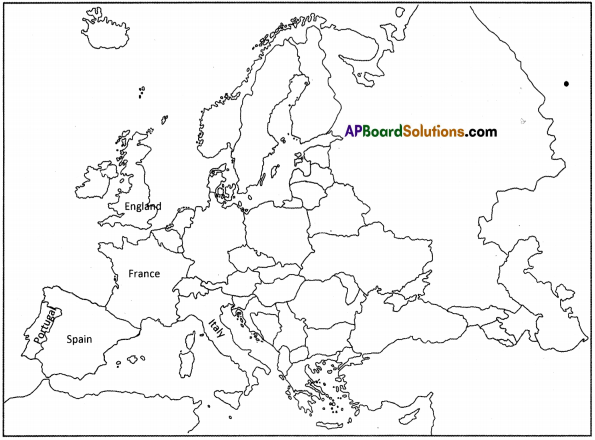
Question 10.
Locate the following on the outline map of Europe.
1) Rome
2) Sicily
3) Adriatic Sea
4) Mediterranean sea
5) Venice.
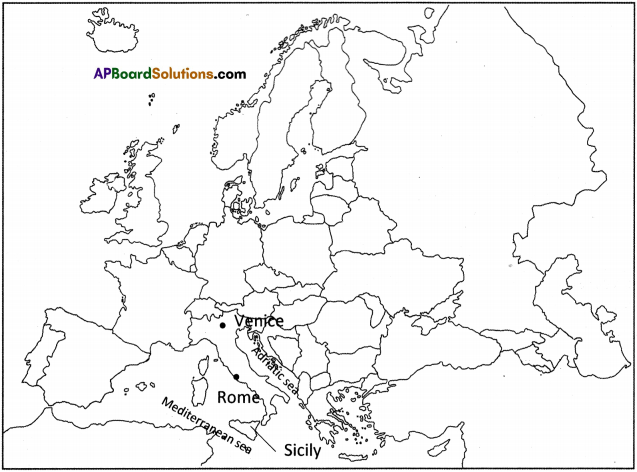
Question 11.
Study the Geographical exploration map (Page No. 156) and locate the following on the world outline map.
1) Indian ocean
2) Atlantic ocean
3) Pacific ocean
4) Cape of Good Hope
5) Philippines
6) Voyage of Columbus
7) Voyage of Magellan
Answer:
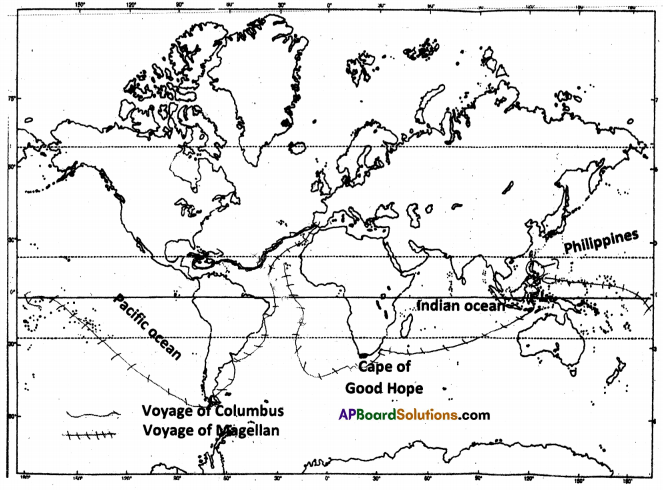
Question 12.
What role did scientists and sailors play in modernizing our world?
Answer:
- Due to the work of Vesalius modern physiology developed.
- Harvey, Newton, Galileo, Copernicus changed the scenario of science in turn changed the world.
- Great sailors like Copernicus, Vasco-da-Gama, Magellan, etc. discovered new sea routes to different countries.
- Due to that, trade and commerce developed.
- Cultural diffusion took place and which in turn laid foundation for modernization.
![]()
Question 13.
Have you seen any painting by any famous artist? If so talk about it to your classmates. Was it realistic? What impression did it make upon your mind?
Answer:
- I have seen a famous painting of M.F. Hussain.
- It is a perfectly proportioned woman painting.
- It is with richness of colours used.
- The colours and designs of costumes are extraordinarily painted.
- The various perspectives of the paintings are worth praising.
